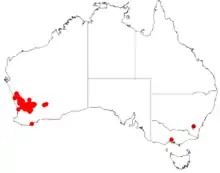Acacia aestivalis
Acacia aestivalis is a shrub belonging to the genus Acacia and the subgenus Phyllodineae that is native to Western Australia.
| Acacia aestivalis | |
|---|---|
| Scientific classification | |
| Kingdom: | Plantae |
| Clade: | Tracheophytes |
| Clade: | Angiosperms |
| Clade: | Eudicots |
| Clade: | Rosids |
| Order: | Fabales |
| Family: | Fabaceae |
| Clade: | Mimosoideae |
| Genus: | Acacia |
| Species: | A. aestivalis |
| Binomial name | |
| Acacia aestivalis | |
 | |
| Occurrence data from AVH | |
Description
The erect and bushy shrub typically grows to a height of 2 to 4 metres (7 to 13 ft).[1] The evergreen phyllodes are straight and have a linear to narrowly oblanceolate shape and a length of 6 to 11 cm (2.4 to 4.3 in) and a width of 2.5 to 7 mm (0.098 to 0.276 in).[2] It blooms from November to December and produces yellow flowers.[1]
Taxonomy
The species was first formally described in 1904 by the botanist Ernst Georg Pritzel as part of the work between Pritzel and Ludwig Diels Fragmenta Phytographiae Australiae occidentalis. Beitrage zur Kenntnis der Pflanzen Westaustraliens, ihrer Verbreitung und ihrer Lebensverhaltnisse as published in Botanische Jahrbücher für Systematik, Pflanzengeschichte und Pflanzengeographie. It was reclassified as Racosperma aestivale in 2003 by Leslie Pedley then transferred back to the genus Acacia in 2006.[3]
The specific epithet, aestivalis, is derived from Latin and means "pertaining to the summer".[4]
Distribution
It is endemic to an area in the Mid West and Wheatbelt regions of Western Australia where it is frequently found along roadsides and on low-lying flats growing in clay, loamy or sandy soils.[1] It is commonly a part of mid-storey of Eucalyptus salmonophloia woodland communities but will also form dense stands in disturbed areas.[2]
See also
References
- "Acacia aestivalis". FloraBase. Western Australian Government Department of Parks and Wildlife.
- "Acacia aestivalis". World Wide Wattle. Western Australian Herbarium. Retrieved 22 January 2019.
- "Acacia aestivalis E.Pritz". Atlas of Living Australia. Global Biodiversity Information Facility. Retrieved 22 January 2019.
- Eggli, Urs; Newton, Leonard E. (2004). Etymological Dictionary of Succulent Plant Names. Berlin, Heidelberg: Springer. p. 4. ISBN 978-3-540-00489-9. Retrieved 12 November 2018.